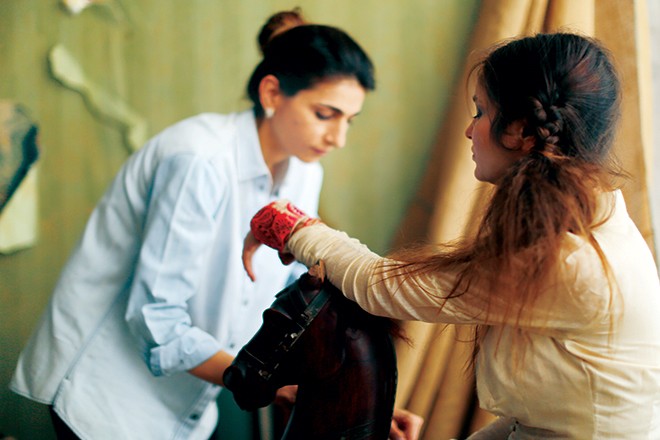

While most designers are busy making mostly disposable clothing, bought off the racks and replaced within a season, there are others - like Layla Chatoor - who prefer to commit themselves to craft that is more timeless.
"Fashion fades; style is eternal," Yves Saint Laurent very famously said, and this is the theory that fashion struggles with today. In a race to keep up with trends, we often forget that the best styles do not have an expiry date. While most designers are busy making mostly disposable clothing, bought off the racks and replaced within a season, there are others - like Layla Chatoor - who prefer to commit themselves to craft that is more timeless.
To discuss her shoot, we met at Layla’s studio, which is tucked away in her tropical paradise of a home. Surrounded on all sides by a lush garden, with gigantic plants and trees holding it in a warm embrace, her home is in fact a reflection of who she is: someone very serene and tasteful. That fact manifests itself further into Layla’s personality, evident as we start talking about her work.
"I’m happy, content doing what I do," she said with a smile when I asked how she dealt with the media juggernaut that brands had to deal with to be relevant today. She explained how staying private and away from the constant scrutiny of the public eye was important to be able to retain her sanity. Things had gone from crazy to manic, with designers expected to be everywhere, all the time. Layla explained how she managed to stay unperturbed by the madness by simply staying away from it. "You’ll probably never see me at social gatherings," she said. "I don’t like to socialize too much, I’m not eager to see my picture everywhere and I feel it takes my focus away from designing."
Layla has been designing for around two decades now and she has managed to create a distinct signature which is heavily inspired by a philosophy of fusion; the same ethos is also reflective in her home. I’ve always said that a designer’s signature has to be a manifestation of his or her personality. Layla’s designs are a reflection of who she is.
There’s a love for tradition, evident in the handcrafted garments in her atelier, but the silhouettes are modern and contemporary. There is also a fusion of Oriental cultures, whether in colours or motifs. It’s all quite exotic.
For the shoot we picked out five classic looks from her atelier, each piece being a classic that one could have worn ten years ago or can wear ten years into the future. Amongst the selection were a couple of pieces of inner wear: a turquoise velvet corset crop top, a fuchsia jamevar bustier and a delicate black lace bustier blouse. To build onto the looks, we picked up a gorgeous silk belted jacket, which had white lace inserts on the sleeves. This jacket, as one can imagine, was timeless. Then there was a full bodied black, raw silk skirt with a dull gold frill at the hem. It flared out like a mermaid’s fin. My favourite piece, however, had to be the ivory blouse that had extra long and rumpled sleeves held together by a risque bodice connected by micro buttons. Fitted perfectly to the model’s body, this blouse came with an equally dramatic layered skirt.
These are the kind of clothes that Layla spoke of as her kind of clothes. "I enjoy making pieces that are timeless and can be modified to look different every time," she explained. "I also love making separates that can be mix and matched. This is exactly what I wanted to do when I was asked to do lawn, but the textile mill just wanted 3-piece joras. I wanted to do a combination of shirt pieces, two-piece outfits, three-piece outfits and also a selection of dupattas only. That really would’ve broadened the market; I felt dupattas would have made the perfect gift, even for women not living in Pakistan. Everyone loves a good scarf."
This is precisely why we took one hot pink dupatta as the hero of one look in the shoot. The idea was also to build on the importance of timeless fashion, which we incorporated in the theme. ‘Child’s Play’ came to mind as a nostalgic throwback to childhood memories of playing with mother’s clothes, draping her dupattas and even stepping into her shoes. We all look for vintage pieces in our mother’s wardrobes; a vintage sari, shawl or gharara that is passed on from generation to generation. In Keats’ words, ‘A thing of beauty really is a joy forever.’
- Photography:Rizwan ul Haq